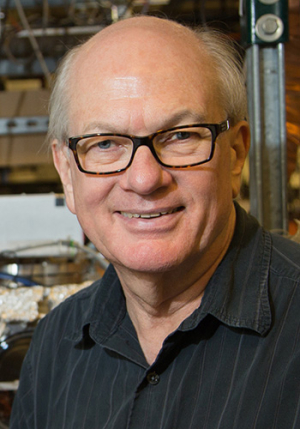Nanopantography technique to create billions of nanotech devices in a matter of hours.
A team of researchers with the University of Houston’s Cullen College of Engineering has filed a patent for new technology that could take nanotech from the lab to the factory.
This nanotech fabrication technique is being developed by Professors Vincent Donnelly and Demetre Economou of the Department of Chemical and Biomolecular Engineering, as well as Assistant Professor Paul Ruchhoeft in electrical and computer engineering.
The idea behind the technology is surprisingly simple, and promises to remove some of the largest practical barriers to mass-producing nanotech devices. Dubbed nanopantography, the technique uses microlenses placed on a substrate (the surface that is being written upon) to divide a single ion beam into billions of smaller beams, each of which writes a feature on the substrate for nanotech device production.
“These lenses act as focusing elements,” said Economou. “They focus the beamlets to a feature 100-times smaller than the lens size. The nanostructures that you can form out of that focusing can be written simultaneously over the whole wafer in predetermined positions.”
A standard lithography technique that can create lenses measuring 100 nanometers wide could therefore be used to draw features just one nanometer wide if combined with nanopantography.
In addition to allowing for the creation of much smaller features, nanopantography has huge advantages of scale over other nanotech fabrication approaches. Direct writing can craft nanofeatures the same size as nanopantography. However these features must be written just a few at a time, as most. This approach would require an extremely long time to process one standard silicon wafer measuring 12-inches in diameter, compared with the potential parallel writing speed that should be possible with nanopantography.
The speed and flexibility of nanopantography, then, “makes it ideal for mass producing a wide variety of nanotech devices, especially when compared to other techniques that are better suited for producing just a few devices at a time for research purposes,” said Economou.
This approach is also notable because nanopantography represents “a new way of thinking about making nanodevices,” said Donnelly, by combining nanometer-sized features with larger sub-micron-sized features, such as the remainder of the electronics on the substrate.
“Nanodevices will not require the whole substrate to contain nanometer-size features. Instead, there will be just parts of the substrate that are nanometer in size, and the rest will be wired up to them. This technology would be a natural way to marry the submicron to the true nanometer world,” Donnelly said.
For example, a feature measuring several nanometers could serve as the heart of a molecular memory device. The operation of that device, however, would be much simpler if controlled by more conventional circuitry that would be sub-micron-sized instead of nanometer-sized.
At the moment, the researchers have successfully written arrays of dots with the technology, and the next step is writing arrays of lines. The research team behind the technology, though, is confident that nanopantography will live up to its potential. When it does, nanotechnology will be a big step closer to mass production and making an impact on our daily lives.


